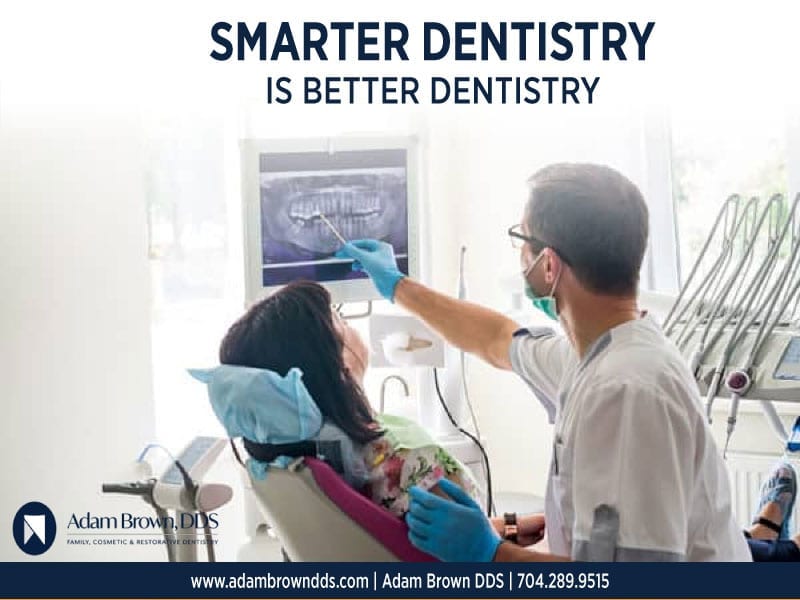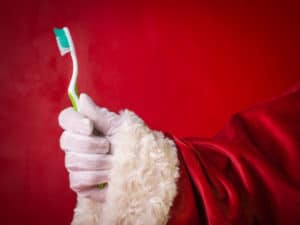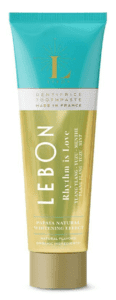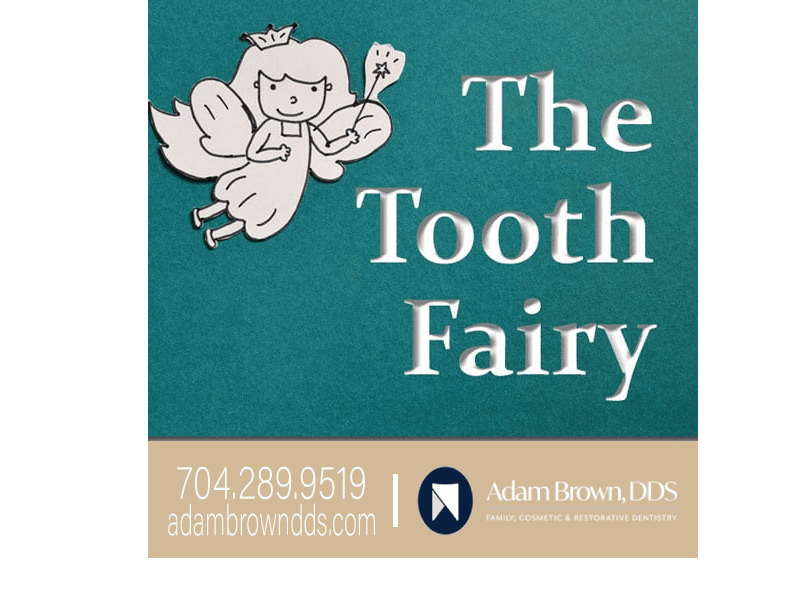Advancements in Dentistry Make for Happier Patients
Better Dentistry is Here and More Advancements are on the Way!
Ah, remember the eighties? Shoulder pads, big hair, and bigger braces! Times and trends have changed, both in fashion and in dentistry.
Gone are the days of walking into an awkward waiting room with uncomfortable chairs and stacks of decade-old magazines, the sounds of drilling in the background. At Carolina’s Dental Choice, our waiting rooms are comfortable with music, televisions, and a welcoming face behind the desk there to help you.
Scheduling options have improved a lot! With more offices offering expanded hours and online appointment scheduling, finding the perfect time to visit the dentist is easy. Reminders can be emailed—you can even have a text message, if you prefer—helping you keep your busy day on track.
One of the biggest advancements is dentistry today isn’t techy or scientific at all. Dentists today discuss procedures to you as they go along, openly explaining treatment options. A visit to the dentist has become less rigid and uncomfortable. Plus, they use hi-tech equipment that is cool and more precise—and less scary!
Specific ways visiting the dentist has changed over the years:
- Hygiene and safety are incredibly important. These days you will see clean and sanitized and newly opened equipment in use. Staff wear gloves and masks for your protection and, as mentioned earlier, there is more communication—a better relationship between staff and patient. It is more evident now than every before that your dentist and dental team are there to help you. You will notice that the dentist or hygienist is telling you what they are doing as they go along. Taking away some of the fear of years gone by when you just laid in the chair and hoped for the best! For your benefit, be clear about any discomfort or issues you have been having prior to your examination. We want you to be completely comfortable!
- Dental insurance. Decades ago, many people did not have the option of obtaining dental insurance through their employer or on their own. With multiple options available now, the staff at the dentist is able to discuss what your procedure will cost in advance when ever possible so you will not be caught unaware. Many dentists will work with you if you don’t have insurance. Another popular option that did not used to exist is buying a dental care package directly through your dentist. This annual plan will include cleanings, X-rays and discounted procedures.
- Extended office hours are becoming more common at dentists around the country. Knowing that many people have day jobs and limited flexibility, Carolina’s Dental Choice opens at 8 a.m. Monday-Wednesday (7 a.m. Thursday-Friday) so you can arrive at work with a smile! In many communities, there are emergency dental offices open in the evenings and weekends for those issues that just cannot wait.
- Advancements in X-rays. There are big changes in this arena. The first use of X-rays in dentistry of a living person in the United States took place in 1896. Advances in dentistry and the availability of the equipment grew and X-rays became part of the normal dental routine in the 1950s. 3-D imaging has become more popular as machines have become more advanced and more available in the medical community. Popular for ultrasounds, mammograms, and other uses, they are helping doctors and dentists better diagnose health issues, while making it easier on the patient. This is truly technology changing lives.
- A cavity’s best friend. Fillings used to appear silver and were in fact made of a combination of metals including: tin, zinc, copper and silver. White fillings (a composite material) started becoming popular in the 1980s, and both the silver amalgam and white fillings are still used in dental practices today. So, what’s new? We now know that fillings, while strong, don’t last forever and advancements in X-rays and exam techniques will help discover issues much sooner.
A brighter smile is now possible!
According to the ADA (American Dental Association), about 1990 was a turning point with new tooth-colored restorative materials, plus increased usage of bleaching, veneers, and implants inaugurate an era of esthetic dentistry.
Whitening of teeth was very rare until recent years, as it seemed like only movie stars and models had truly pearly whites. Today you can choose from whitening options including bleaching and whitening trays, just to name a few.
Restorative dentistry has seen great advancements in the last twenty years. In the past, if you had a tooth removed, you learned to live with that gap in your mouth. Missing teeth can be unattractive and negatively affect your eating habits, because missing teeth also make the remaining teeth work harder. At Carolina’s Dental Choice, we provide restorative, or prosthodontic. This process involves repairing or replacing bad teeth in order to restore the mouth. This can involve multiple procedures, including using fillings, crowns, veneers, bridges, dental implants, and partial dentures. The main goal of restorative dentistry is to preserve the natural teeth as much as possible and to give you the smile that you deserve. The use of dental implants, partial dentures and other restorative tools, is important if teeth are to be removed.
Braces used to be the first thing you noticed if someone had them and some kids just wanted to avoid having them altogether, with those sharp wires and clunky metal brackets. Traditional braces caused sores, were tricky to keep clean, and restricted enjoying many favorite snacks. Having straighter teeth is beneficial for appearance, but also for the health of your teeth. A popular option for youth and adults today is Invisalign Braces. This modern approach is less invasive and much more attractive.
New ideas in dentistry:
- Pediatric dentistry. Specialty dentists for kids began popping up around 15 years ago. Because dentists can be intimidating for kids, these new specialty pediatric practices feature graphics, games, and friendly and familiar themes making kids feel engaged and safe. In general, they’ve had additional and specialized training in pediatric dentistry and can work with babies through teens more effectively than ever.
- No gain from pain. Back in the day, people only went to the dentist when they were in pain. Because of this, the opportunity to prevent issues was often lost and going to the dentist became associated with pain and, for some, trauma. Getting into the habit of twice-yearly check-ups with cleanings will allow the dentist to look for problems in advance of you having to have a dental emergency. Dentistry has become incredibly preventative. X-rays, oral exams, and cleanings all help detect current and potential future problems. Most dental insurance plans cover much, if not all, of this cost and offer discounts on any additional procedures required.
- Gum disease used to be something patients had to live with. Gum disease is generally not curable, but it is treatable and more importantly, preventable. Prevent gum disease by seeing your dentist on a regular basis—at least twice a year. Early stages can be treated with a dental hygiene therapy called scaling and root planning. While it might sound scary or like an outdoor adventure, the treatment is actually a deep cleaning measure that helps fight back against gum disease. This is a nonsurgical procedure to treat your teeth and gums against plaque, bacteria, and tartar deposits.
- Beyond the teeth. Checking for oral cancer is another recent addition to a routine dental check-up. Your dentist can examine your oral tissues easily by looking at your lips and inside your mouth, as well as, check your gingivae (gums) carefully, the inside of your cheeks and your tongue (the sides and underneath). The more preventative we are today, the brighter your future!
- More options than ever. Some still have a slight fear of going to the dentist and the potential pain of dental treatments. In the past, they had little options and would avoid getting needed dental work and even check-ups. But today there is I.V. sedation. Intravenous (I.V.) sedation has become more common and works well for those with fear of the dentist and dental procedures. It is also ideal for patients whose fear of dentistry has led to a large amount of dental work needing to be completed. V. Sedation is also used for outpatient procedures, like colonoscopies. Referred to as “twilight sleep,” you will wake with little or no memory of the procedure. Anesthesia is given via the I.V. and recovery requires someone take you to/from the procedure.
Healthy at home, advancements and options:
Advances in types of toothbrushes have made cleaning your teeth much more thorough and, dare we say, even fun! Gone is the “one size fits all” toothbrush of 20-30 years ago. Now there are multiple sizes and types of bristles, easy to grip handles, and electronic versions on the market in all price ranges.
Flossing is an important thing to do at least daily (after every meal is ideal) to remove plaque and excess food particles. Many types of floss are on the market now (vs. one type fits all 20 or so years ago). Flavored floss, flosser sticks (or picks), waxed and unwaxed string floss, dental tape, electric flossers and natural floss are all options available.
Water picks (the most commonly known one being manufactured by Waterpik) are water flossers that are handy for reaching those hard to get to teeth in the back. These come in a variety of price points and models, from table top to hand held.
With all dental tools, check with your dentist about the best fit for you and their recommendations.
The more we know, the better your health:
Poor oral health has been debated as a possible cause of heart disease for years. In 2012, experts from the American Heart Association reviewed the available scientific evidence and concluded that poor oral health hasn’t been proved to cause heart disease — and that treating existing gum disease hasn’t been proved to reduce the risk of heart disease. Still, studies have shown:
- Gum disease (periodontitis) is associated with an increased risk of developing heart disease.
- Poor dental health increases the risk of a bacterial infection in the blood stream, which can affect the heart valves.
- Tooth loss patterns are connected to coronary artery disease.
- There is a strong connection between diabetes and cardiovascular disease and evidence that people with diabetes benefit from periodontal treatment.
Even though oral health isn’t a key to heart disease prevention, it’s important to take care of your teeth and gums:
- Brush your teeth at least twice a day.
- Floss daily.
- Schedule regular dental checkups and cleanings.
- Protect yourself by learning more about the connection between your oral health and overall health. Remember, be preventative!
The connection between oral health and overall health:
- Like many areas of the body, your mouth is teeming with bacteria, most of them harmless. Normally the body’s natural defenses and good oral health care, such as daily brushing and flossing, can keep these bacteria under control. However, without proper oral hygiene, bacteria can reach levels that might lead to oral infections, such as tooth decay and gum disease.
- Certain medications — such as decongestants, antihistamines, painkillers, diuretics, and antidepressants — can reduce saliva flow. Saliva washes away food and neutralizes acids produced by bacteria in the mouth, helping to protect you from microbial invasion or overgrowth that might lead to disease.
- Studies also suggest that oral bacteria and the inflammation associated with periodontitis, a severe form of gum disease, might play a role in some diseases.
So even if you still have big hair, shoulder pads, or drive your DeLorean to the office, the team here at Carolina’s Dental Choice is ready to treat your dental health needs, whatever they may be. Let us help you take preventative measures to keep your smile bright and glowing into the future.
*Mayo Clinic

 Perhaps when you were younger, Santa stuffed your Christmas stocking full of chocolate coins and peppermint twists — and a new toothbrush to remind you not to let all that candy rot your teeth. Santa’s always been a smart guy.
Perhaps when you were younger, Santa stuffed your Christmas stocking full of chocolate coins and peppermint twists — and a new toothbrush to remind you not to let all that candy rot your teeth. Santa’s always been a smart guy. Not crafty? No worries! The artists of
Not crafty? No worries! The artists of 




